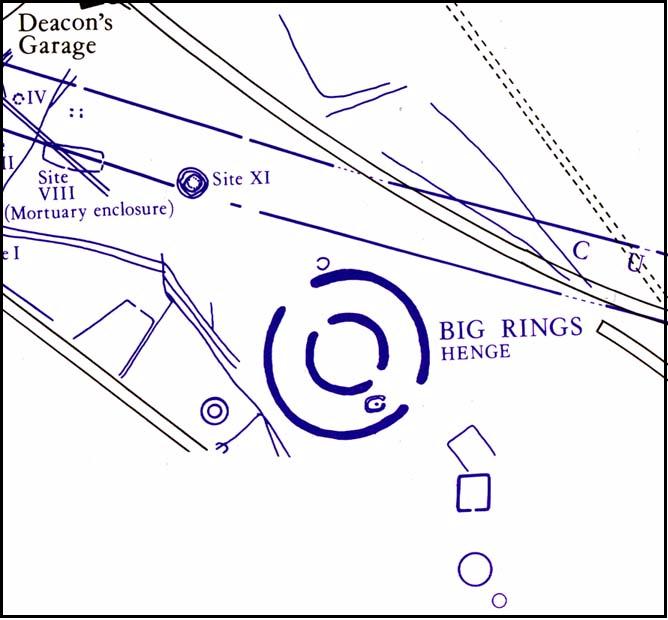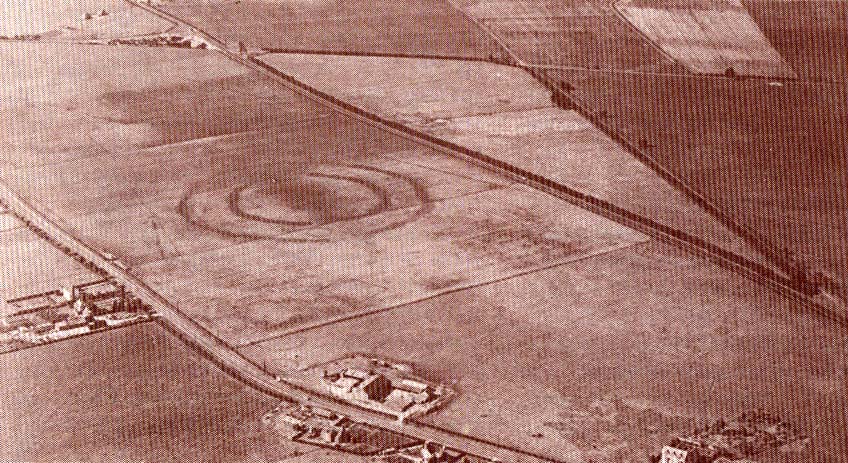Henge (destroyed): OS Grid Reference – SU 572 953
Archaeology & History
Very close to the once impressive Dorchester Cursus, this double-ringed prehistoric monument can no longer be seen thanks to the self-righteous arrogance of modern industrialists who care little for the ancestral monuments of the British people, destroying all traces of the site — an activity which, in this case, astonishingly started in more ancient times, as Jean Cook (1985) told: “The banks and the ditches had been levelled through agricultural activity, possibly in the Iron Age”!


The destruction of this environment continues to this day, destroying many important archaeological remains with little care. Thankfully we we’ve got a good account of the site due to the archaeological excavations of R.J.C. Atkinson (1951) and his team in the late-1940s, from whom Cook and just about everyone else gets most of their data regarding the site.
The Big Rings Henge was probably built sometime in the middle of the second millenium BC. It was an important prehistoric ritual site and, most likely, had some relevance to the adjacent cursus monument. A number of important mortuary and ritual sites were also built close to the site over a period of nearly two thousand years, showing the importance this landscape had to our ancestors.
Jean Cook (1985) described the Big Rings henge as follows:
“The ditches, of which there were two, had opposed entrances on the NNW and SSE. They were about 7.6m wide and 1.8m deep with flat bottoms. Originally there seems to have been a broad low bank on the inner side of each ditch. The southern entrance incorporated an existing monument, consisting of a ring ditch which enclosed a large four-post setting and contained a cremation and a stone axe. Just outside the north entrance was a round barrow, containing a central oval burial pit which produced a crouched inhumation, together with a well-preserved beaker, two small copper or bronze knives and a rectangular wrist-guard of greenstone. The Big Rings ditches themselves contained pottery belonging to the middle or late Beaker period. Although the area within the ditches was trenched, there was no evidence of internal timber structures.”
References:
- Atkinson, R.J.C., “The Henge Monuments of Great Britain,” in Atkinson, Piggott & Sandars’ Excavations at Dorchester, Oxon (Department of Antiquities: Oxford 1951).
- Atkinson, R.J.C., Piggott, C.M. & Sandars, N.K., Excavations at Dorchester, Oxon, Department of Antiquities: Oxford 1951.
- Cook, Jean, “The Earliest Evidence,” in Dorchester through the Ages, Oxford University 1985.
- Harding, A.F., Henge Monuments and Related Sites of Great Britain, BAR 175: Oxford 1987.
- Harding, Jan, The Henge Monuments of the British Isles, Tempus: Stroud 2003.
- Wainwright, Geoffrey J., The Henge Monuments: Ceremony and Society in Prehistoric Britain, Thames & Hudson: London 1989.
© Paul Bennett, The Northern Antiquarian
The map could not be loaded. Please contact the site owner.